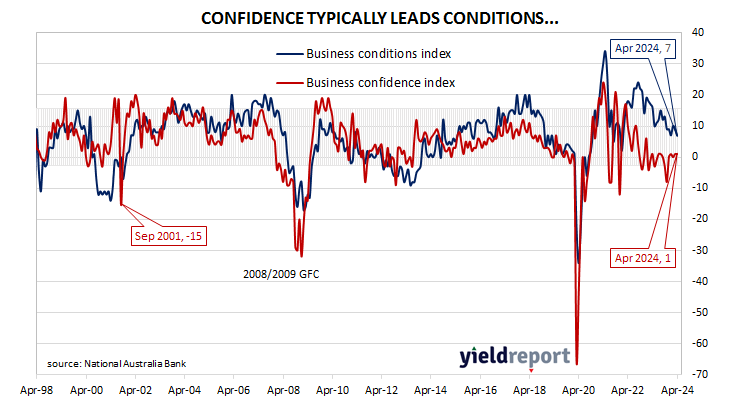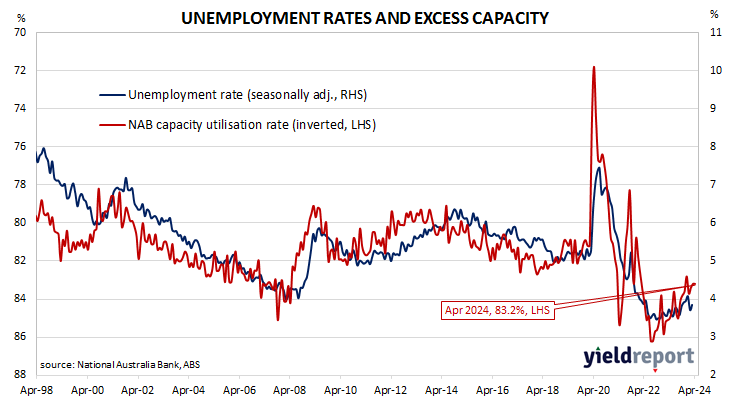Summary: Business conditions decline in April; business confidence steady, below average; signs of slowing activity, easing costs support outlook for gradual improvement in inflation; ACGB yields a little higher; rate-cut expectations firm a touch; Westpac: conditions to remain challenging in first half of 2024, followed by gradual recovery in second half; capacity utilisation rate unchanged, still at elevated level.
NAB’s business survey indicated Australian business conditions were robust in the first half of 2018, with a cyclical-peak reached in April of that year. Readings from NAB’s index then began to slip and forecasts of a slowdown in the domestic economy began to emerge in the first half of 2019 as the index trended lower. It hit a nadir in April 2020 as pandemic restrictions were introduced but then improved markedly over the next twelve months and has subsequently remained at robust levels.
According to NAB’s latest monthly business survey of around 400 firms conducted in the last two weeks of April, business conditions declined to a level which is just above the long-term average. NAB’s conditions index registered 7 points, down 2 points from March’s reading.
Business confidence remained steady. NAB’s confidence index was unchanged at 1 point, a reading which is below the long-term average. Typically, NAB’s confidence index leads the conditions index by one month, although some divergences have appeared from time to time.
“Overall, these signs of slowing activity and easing costs support the outlook for gradual improvement in inflation from here, but how quickly this occurs remains to be seen,” said NAB Chief Economist Alan Oster.
Australian Commonwealth Government bond yields generally moved a little higher, lagging the rises of US Treasury yields on Friday night (AEST). By the close of business, the 3-year ACGB yield had returned to its starting point at 3.96%, the 10-year yield had crept up 1bp to 4.34% while the 20-year yield finished 2bps higher at 4.65%.
In the cash futures market, expectations regarding rate cuts in the next twelve months firmed a touch. At the end of the day, contracts implied the cash rate would remain close to the current rate for the next few months and average 4.32% through June and 4.355% in August. November contracts implied 4.35% and February 2025 contracts implied 4.275%. However, May 2025 contracts implied 4.16%, 16bps less than the current rate.
“From a big picture perspective, little has changed in April,” said Westpac senior economist Pat Bustamante. “Conditions continue to gradually trend lower but remain around long-run average levels, while businesses are still cautious about the future. 2024 is expected to be a year of two halves. While conditions remain challenging in the first half of the year, a gradual recovery is expected to take place from the second half of 2024, before picking up more pace into 2025.”
NAB’s measure of national capacity utilisation remained steady at 83.2%, a level which is still quite elevated from a historical perspective. Six of the eight sectors of the economy were reported to be operating at or above their respective long-run averages.
Capacity utilisation is generally accepted as an indicator of future investment expenditure and it also has a strong inverse relationship with Australia’s unemployment rate.



